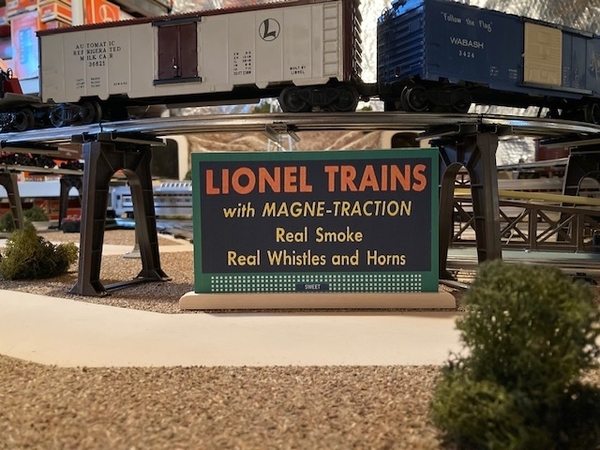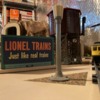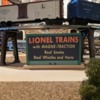Originally Posted by WftTrains:
Andrew:
Yes those dealer display billboard signs you have pictured are very rare but be advised that those signs were not made in the 3” x 5” size that fit into the 310 billboard frames. I have one of those signs and it is 4” x 6¾” and made of much heavier cardboard so it can stand by itself in a slot in a wooden base. I can send you a photo of mine if you would like.
But there were other Lionel dealer display signs that were 3” x 5” and designed to fit in the post-war #310 frames. Several have been listed on eBay recently. Attached is a pdf file which shows 2 of the 4 known colorful 3” x 5” dealer display signs. The 3rd one was red and yellow and had a drawing of a steam whistle with the text “Lionel Trains with built-in Remote Control Whistle”. The 4th had a blue background with red lettering and showed a large cloud of white smoke coming out of the smoke stack of a black steam locomotive with the text “Lionel Locos puff clean white smoke”.
In addition there was a set of eight 3" x 5" signs which were just plain black text on a white background with each one identifying a different 1961 cataloged train set.
There are several sellers on eBay listing reproduction Lionel billboards for sale so it must not be hard to duplicate them. Some of the ones they are identifying as reproductions were never made by Lionel!
HTH,
Bill (BTW also a Nittany Lion)
Hi Bill:
Yes, I saw those on eBay recently- something fishy is going on with the seller as he's reposted them several times at higher prices each time.
I am building a reproduction D-148 and am including the wooden base of which you speak on one corner- it'll look something like the below picture when done (though not as good as an original). My concern in searching what others have done for reproductions (even those selling them) is that the material seems to be much lighter, or downright incorrect.
I am glad you pointed out it's bigger than the standard inserts, I had no idea on that.
I'll hit Staples and Office Depot and the like and see what material I can find- I know it'll need to be somewhat glossy to look correct, and heavy enough to stand up on its own.
Thanks for the help! Go State!












